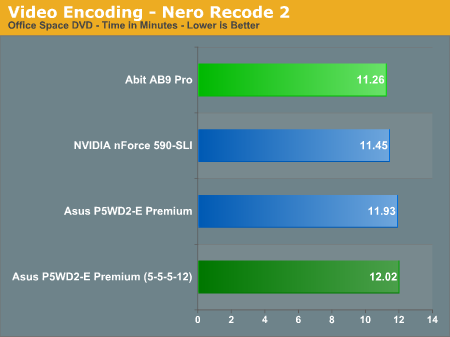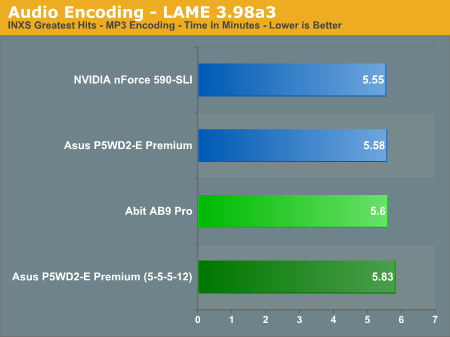Abit AB9 Pro: A sneak peek at Intel's new P965 chipset
by Gary Key on July 3, 2006 3:45 AM EST- Posted in
- Motherboards
Media Encoding Performance
For media encoding, our first test is quite easy - we take our original Office Space DVD and use AnyDVD Ripper to copy the full DVD to the hard drive without compression, thus providing an almost exact duplicate of the DVD. We then fire up Nero Recode 2, select our Office Space copy on the hard drive, and perform a shrink operation to allow the entire movie along with extras to fit on a single 4.5GB DVD disc. We left all options on their defaults except we checked off the advanced analysis option. The scores reported include the full encoding process and is represented in minutes, with lower numbers indicating better performance.

The results left us amazed with the Abit P965 board scoring 7% better than the Asus i975X board at the same memory settings while still bettering our NVIDIA board that placed first in our previous tests. We ran the benchmark several times and verified our settings before accepting the test results. It will be interesting to see if this pattern continues with other P965 based boards.
Audio Encoding Performance
While the media encoding prowess of the Abit AB9 Pro was superb in our initial media encoding testing, we wanted to see how it fared on the audio side. Our audio test suite consists of Exact Audio Copy v095.b4, LAME 3.98a3, LAME MT3.97a-MS Compiler, and Nero Digital Audio. We utilize the INXS Greatest Hits CD that contains 16 tracks totaling 606MB of one time '80s hits.
Our first test consists of utilizing Exact Audio Copy as the front end for our differing versions of LAME. We set up EAC for variable bit rate encoding, burst mode for extraction, use external program for compression, and to start the external compressor upon extraction. (EAC will read the next track while LAME is working on the previous track, thus removing a potential bottleneck with the optical drive.)
Our two versions of LAME consist of the recently released 3.98a3 and LAME MT 3.97a, which is a multi-threaded version of the LAME MP3 encoder. LAME MT was originally designed as a demonstration to show the advantages of multi-threading on the Pentium 4 with Hyper-Threading enabled. Instead of running multiple parallel threads, LAME MT generates the encoder's psycho-acoustic analysis function in a separate thread from the rest of the encoder using a simple linear pipeline. The results are presented in minutes for the encoding process, with lower numbers being better.


As in the media encoding section, the more intensive CPU and storage system tests seem to favor the P965 over the i975X when running at the same memory timings and are near that of the two results at lower memory timings. Even at this early stage we see some benefits of the reworked/enhanced memory controller on the P965. When utilizing LAME MT we see upwards of a 35% improvement in encoding times. This once again shows the advantages of programs written to take advantage of multiple-core processors.
For media encoding, our first test is quite easy - we take our original Office Space DVD and use AnyDVD Ripper to copy the full DVD to the hard drive without compression, thus providing an almost exact duplicate of the DVD. We then fire up Nero Recode 2, select our Office Space copy on the hard drive, and perform a shrink operation to allow the entire movie along with extras to fit on a single 4.5GB DVD disc. We left all options on their defaults except we checked off the advanced analysis option. The scores reported include the full encoding process and is represented in minutes, with lower numbers indicating better performance.

The results left us amazed with the Abit P965 board scoring 7% better than the Asus i975X board at the same memory settings while still bettering our NVIDIA board that placed first in our previous tests. We ran the benchmark several times and verified our settings before accepting the test results. It will be interesting to see if this pattern continues with other P965 based boards.
Audio Encoding Performance
While the media encoding prowess of the Abit AB9 Pro was superb in our initial media encoding testing, we wanted to see how it fared on the audio side. Our audio test suite consists of Exact Audio Copy v095.b4, LAME 3.98a3, LAME MT3.97a-MS Compiler, and Nero Digital Audio. We utilize the INXS Greatest Hits CD that contains 16 tracks totaling 606MB of one time '80s hits.
Our first test consists of utilizing Exact Audio Copy as the front end for our differing versions of LAME. We set up EAC for variable bit rate encoding, burst mode for extraction, use external program for compression, and to start the external compressor upon extraction. (EAC will read the next track while LAME is working on the previous track, thus removing a potential bottleneck with the optical drive.)
Our two versions of LAME consist of the recently released 3.98a3 and LAME MT 3.97a, which is a multi-threaded version of the LAME MP3 encoder. LAME MT was originally designed as a demonstration to show the advantages of multi-threading on the Pentium 4 with Hyper-Threading enabled. Instead of running multiple parallel threads, LAME MT generates the encoder's psycho-acoustic analysis function in a separate thread from the rest of the encoder using a simple linear pipeline. The results are presented in minutes for the encoding process, with lower numbers being better.


As in the media encoding section, the more intensive CPU and storage system tests seem to favor the P965 over the i975X when running at the same memory timings and are near that of the two results at lower memory timings. Even at this early stage we see some benefits of the reworked/enhanced memory controller on the P965. When utilizing LAME MT we see upwards of a 35% improvement in encoding times. This once again shows the advantages of programs written to take advantage of multiple-core processors.










33 Comments
View All Comments
CYBERX1800XT - Thursday, July 6, 2006 - link
it's going to take alot to convince me that abit's quality in electroitics(resistors,capicitors,pnp transistors and voltage regulators) hasn't overshadowed there so-called new make over. all i have to say is 'anyone remember the abit be-6 revision 2?? i do,,i also remember 12 hours after buying an abit mobo,,at least 14 caps literally blew up. so all this halla-ballhooey about the product line refreshment may just be hype. i'm not scowling at anyone at anandtech,,i believe and trust there reviews. who i don't trust is abit's choice in 2nd or 3rd rate electroitics. besides,,who cares,,this is a rather whimpy board. for the cost of this mobo,,you could easily spend 20 more bucks and get a ASUS A8R-MVP,,and have crossfire to boot. i'm sorry to sound so negative,,but abit left a bad taste in my mouth in 2000. and it has yet to have left. i honestly apologize to everyone at anandtech. not demeaning any of you guys,i totally trust your revievs. but i switched to amd,,and i only bought 1 abit board. and that will never happen again. i will ONLY use ASUS!!!araczynski - Wednesday, July 5, 2006 - link
personally i find the inclusion of onboard audio on ALL motherboards to be quite the waste of consumer dollars. what kind of an "enthusiast" puts up with onboard audio? granted its more then fine for windows, but when you're aiming a mobo at an enthusiast you don't have to make him pay for some crappy soundchip that he'll never do more with then disable in the bios.and yes, get rid of the floppy connector (usb version for those that can't live without them).
Pirks - Wednesday, July 5, 2006 - link
Not quite that simple - it's actually cheaper to make mobos with audio than without it. With audio you have one manufacturing line cranking out mobos, just one model => CHEAP. If you wanna get mobos w/o audio, you gonna get TWO manufacturing lines cranking out mobos => EXPENSIVE. This is why they always produce only ONE SINGLE MOBO MODEL, EVERYTHING INCLUDED - all the floppy and legacy crap - 'cause that's CHEAP. You go to options, exclude this, exclude that blah blah - and the price -wooosh!- soars up to clouds and the blue sky :)bob4432 - Wednesday, July 5, 2006 - link
glad to see a floppy is still around. i am probably the only person that uses one, but i appreciatet the m/b manf for taking me into consideration :Dafrodite - Tuesday, July 4, 2006 - link
Say what!?!The problem here is the boneheaded optical drive manufacturers not using SATA on their drives, not Intel removing obsolete technology.
I say:
Get rid of PATA
Get rid of Floppy-drives
Get rid of mouse and keyboard ports
Then use all that lovely real estate on the board to put a digital tv receiver or bluetooth-module or wifi or firewire or just more USB-slots or whatever you want..
Please, what year is it now, 2006 or 1996.. floppydrive connectors on a "next-gen motherboard"??
mine - Saturday, July 8, 2006 - link
second thatiwhat about the following scenario.... you will never forget that :
3 young Mac videoeditors rolling on the floor with wet trousers looking @ a Windows XP install with an open case
an attached floppy and F6
these people have never seen a floppy in their whole life and these things are one click away on Mac OS X
Pirks - Tuesday, July 4, 2006 - link
Hmm, why this smells like a Mac? ;)JarredWalton - Tuesday, July 4, 2006 - link
Until we have the replacements ready, completely removing support for older technologies is jumping the gun. We need a next-generation operating system that doesn't ever require a floppy drive (which we will get with Windows Vista). More importantly, we need SATA optical drives that are at least as good as the PATA counterparts, and with equivalent prices. Right now, I'm only aware of one company making SATA DVDR drives (Plextor), and the consensus seems to be that the drives aren't all that great. Widespread support for SATA optical drives (meaning software support -- what good is a DVDR if your favorite burning application doesn't support it?) is still lacking.The end result is that every motherboard manufacturer that uses ICH8 is pretty much forced to include another chip on the motherboard to handle IDE support. Intel isn't getting rid of IDE support; they're just placing the burden of including such support on the motherboard manufacturers. Seriously, how many transistors does it take to support IDE? Perhaps the reason it was removed was to reduce pin counts on the Southbridge, but I doubt it. We're not even asking for anything special in terms of IDE support; just include the same old IDE support that has been present on motherboards for the past decade or so.
jonp - Monday, July 3, 2006 - link
Is the Zalman unit "stock"?
Gary Key - Monday, July 3, 2006 - link
We used the stock retail heatsink for all testing except overclocking. We use the Zalman for overclocking and also tried the Tuniq 120 for fitment issues.